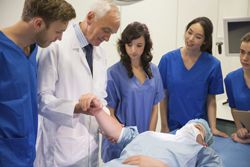Mayo Medical School is preparing med students for a challenging future
Editor’s note: Sensing a gap between how physicians are educated and the future needs of the U.S. healthcare system, the American Medical Association in 2013 launched its “Accelerating Change in Medical Education” initiative. The association awarded grants to 11 medical schools to fund selected innovations in medical education, and then expanded the program in 2015 to an additional 21 schools. Here’s a look at one program shaping tomorrow’s physicians.
 Tomorrow’s physicians will possess abundant clinical skills. But they will also bring a broader outlook to their profession than many of their predecessors. At least that’s how the educators at Mayo Medical School in Rochester, Minn., see things.
Tomorrow’s physicians will possess abundant clinical skills. But they will also bring a broader outlook to their profession than many of their predecessors. At least that’s how the educators at Mayo Medical School in Rochester, Minn., see things.
“Healthcare delivery is changing at a phenomenal rate. How I practiced five or ten years ago is very different from how I practice today,” says Liselotte “Lotte” Dyrbye, M.D., MHPE, professor of medicine. Mayo is one of the 32 medical schools across the nation taking part in the American Medical Association’s “Accelerating Change in Medical Education” initiative, designed to help tomorrow’s doctors respond to a rapidly changing medical landscape.
Agents for change
Mayo’s 2015-2016 first-year medical students were the first to experience a new core curriculum, focusing on six Science of Health Care Delivery (SHCD) domains:
- High-value care
- Population-centered care
- Team-based care
- Leadership
- Person-centered care
- Health policy, economics, and technology
The SHCD curriculum, developed in collaboration with Arizona State University, uses a blended learning format in which students participate in online learning modules connected to in-class experiences, says Dyrbye. This way, “when they come into the classroom, it’s more about understanding and discussion.”
This new core curriculum aims to educate students to be not just doctors, but leaders in healthcare reform. To that end, students also have the option to pursue a master’s degree in Science of Health Care Delivery in tandem with their medical degree. The master’s degree will enable students to become agents for healthcare system changes, says Stephanie Starr, M.D., assistant professor of pediatrics at Mayo Medical School. “They will be uniquely positioned to close gaps related to healthcare delivery, lead change and affect policy.”
Starts at home
Mayo’s program places students’ well-being at the forefront. Dyrbye, who has researched the topic extensively, notes that depression and burnout tend to affect medical students – whose education requires significant time, energy, and money – more so than students in other areas.
The THRIVE component of Mayo’s program provides students with several resources. Most notably, they learn about wellness in their classes. Additionally, they have access to the Dan Abraham Healthy Living Center on the medical school campus, which offers workout and exercise facilities – as well as consultations in nutrition and stress management – to Mayo’s employees.
Students also have access to online resources, including self-assessment tools to monitor their own emotional health, and national and local information about how to reduce stress, optimize their health, access care, and manage debt.
“We’re working on building social support,” says Dyrbye. This support system connects students with faculty and with each other, through one-on-one advisor meetings and small groups sessions. “It’s more than just about individual strategies,” she says. “We do a lot of work around optimizing our learning environment.”
Working as a group
The opportunity to work with the other 31 schools in the American Medical Association consortium has been a delight, says Starr. “As we all seek to have individuals enter residency with specific healthcare delivery expertise, we’re going to be able to move more quickly if we can agree across schools what graduates must be able to know and do, regardless of which school they attended.” As examples, she points to assessment and cost-efficiency tools that can be shared across the consortium to gauge success.
Dyrbye adds that the grant has allowed educators such as those at Mayo to innovate at a much faster pace than they would have without the AMA initiative. “The richness of being able to come together with similarly minded individuals, from underserved communities to private schools,” has made the consortium work well together, she says.
“Students are traditionally trained to learn basic science and clinical skills,” says Starr. “But if we as physicians don’t know all of these other pieces – around financing, healthcare improvement, and social determinants of health – then all those efforts around the clinical skills will not fully pay off.”
